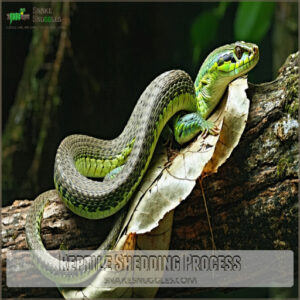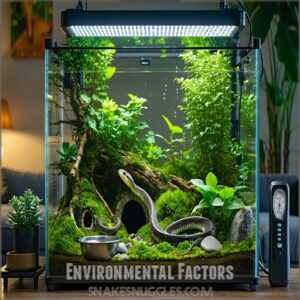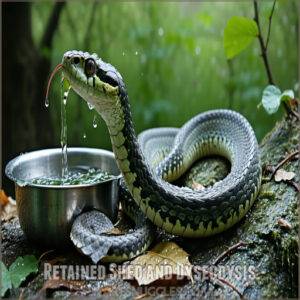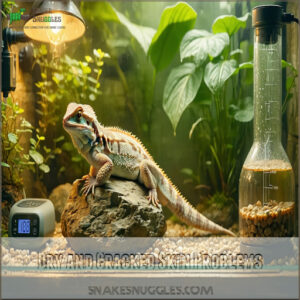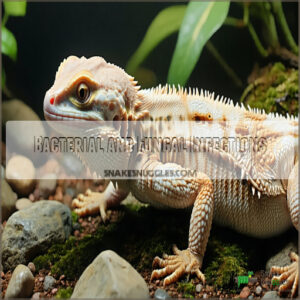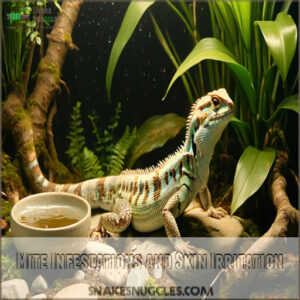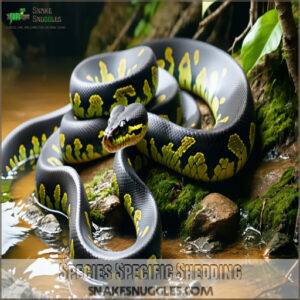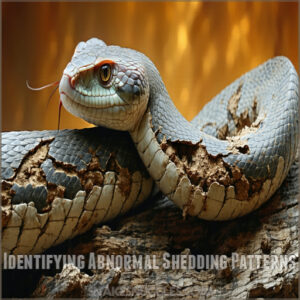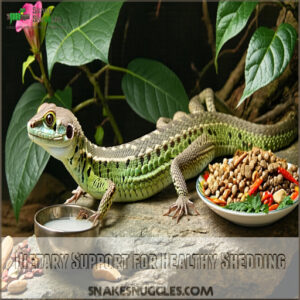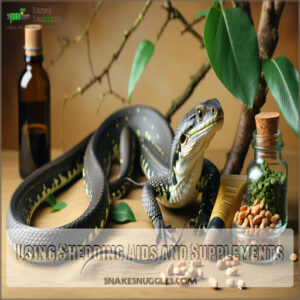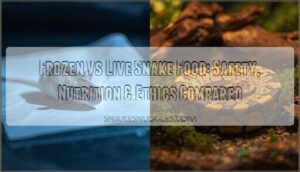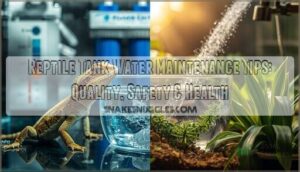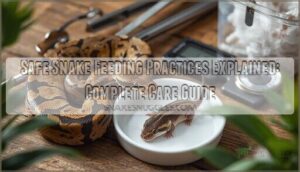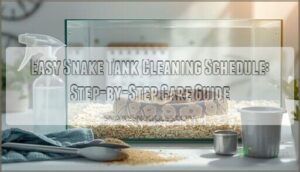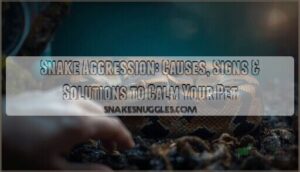This site is supported by our readers. We may earn a commission, at no cost to you, if you purchase through links.
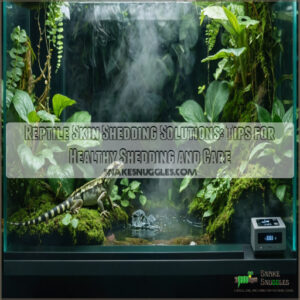
Keep humidity levels between 40-60% using a hygrometer, and set up a humidity hide with damp moss where your reptile can relax.
Proper nutrition is essential – balance their diet with vitamin A and E supplements to support healthy skin renewal.
If you notice incomplete shedding, don’t panic – specialized shedding aids and gentle soaks can help.
Different species have unique needs, from lizards shedding in patches to snakes losing their entire skin at once.
Understanding these patterns opens up a world of customized care techniques, and helps you provide the best support for healthy skin renewal.
Table Of Contents
- Key Takeaways
- Reptile Shedding Process
- Environmental Factors
- Common Skin Issues
- Species Specific Shedding
- Health Monitoring and Solutions
- Frequently Asked Questions (FAQs)
- How do you get rid of skin on a reptile?
- Do reptiles shed skin?
- Does shedding affect a reptile’s health?
- What made mass shedding more feasible for reptiles?
- How do you know if a reptile is shedding?
- Do reptiles get cranky during shedding?
- What to do when your reptile is shedding?
- Should you help a lizard shed its skin?
- Do reptiles ever stop shedding?
- How do you get rid of reptile skin?
- Conclusion
Key Takeaways
- You’ll need to maintain humidity levels between 40-60% and set up a humidity hide with damp moss for your reptile to ensure proper shedding – use a hygrometer to monitor conditions precisely.
- You should balance your reptile’s diet with vitamin A and E supplements while providing proper calcium intake, as nutrition directly impacts the shedding process and skin health.
- You’ll want to adapt your care routine to your specific species’ needs – snakes shed in one piece and require 40-60% humidity, while lizards shed in patches and need 60-80% humidity for optimal results.
- You can help prevent shedding problems by keeping the enclosure clean, providing appropriate substrate options like coconut fiber or moss, and offering shallow water dishes for proper soaking.
Reptile Shedding Process
Shedding is a natural process that helps reptiles grow and renew their skin.
By understanding the specific needs of your reptile, you can facilitate smooth shedding and minimize potential health issues.
Natural Growth and Renewal
Reptile skin shedding is nature’s built-in renewal process, enabling growth and fresh layers of new skin.
Think of it like a wardrobe update for your reptile! This shedding cycle sheds old, worn-out skin to maintain health and remove parasites.
Snakes utilize humidity retreat boxes for proper shedding. To keep the renewal process smooth, provide proper humidity and a well-balanced diet—essential shedding solutions for a stress-free reptile skin care routine.
Variations Among Species
Shedding patterns vary as widely as reptile diversity itself.
Lizards often shed in patches, while snakes lose their skin in one impressive piece, revealing their genetic traits and behavior.
These differences mean lizard shedding problems are distinct from snake shedding problems.
Understanding species traits helps you tailor shedding solutions for lizards and shedding solutions for snakes, ensuring healthier, smoother skin renewal for your scaly companions.
Importance of Proper Diet
A balanced reptile diet is key for smooth shedding.
Offer food variety like insects or leafy greens and make sure proper calcium intake.
Nutrient balance matters—don’t skimp on vitamins A and E! Use dietary supplements to replenish nutrients if needed.
Think of shedding as their “glow-up”; poor nutrition? No shine. Keep meals species-specific for the best results!
Humidity and Temperature Requirements
Keeping moisture levels in check is a dance of balance.
Use a hygrometer to track reptile humidity levels, ensuring proper humidity.
Pair this with thermal gradients for temperature control.
A humid hide can ease shedding, while a well-maintained reptile shedding enclosure prevents stuck shed.
Routine misting or soaking helps too, but overdoing it might invite respiratory issues.
Understanding proper snake humidity requirements is essential for a healthy shedding process.
Environmental Factors
You can’t overlook environmental factors when considering your reptile’s shedding. Maintaining the right humidity, temperature, and habitat setup maintains their skin health and shedding process.
Humidity Management and Monitoring
A hygrometer is your secret weapon for nailing reptile humidity levels.
Monitor and adjust moisture to prevent dry, flaky sheds.
Create a reptile shedding enclosure with ideal conditions by:
- Adding a humidity hide with damp moss for relaxation.
- Using water management tricks like misting or shallow bowls.
- Balancing moisture control with proper temperature gradients.
Proper reptile care involves understanding reptile shedding to maintain a healthy environment.
Your reptile will thank you for providing the right environment with proper humidity levels.
Heating and Lighting Considerations
A proper thermal gradient keeps your reptile comfortable and supports healthy shedding.
Use heat sources like ceramic heaters or heat mats for reliable temperature control. UVB lighting supports vitamin D3 synthesis, promoting overall skin health.
Combine lighting options for day-night cycles. Skip cheap bulbs—they’re unreliable and stress-inducing.
Balanced heat and UVB light serve as your reptile’s ultimate shedding aid, supporting healthy shedding and overall skin health.
Providing Water and Substrate Options
Soaking methods and substrate types play a big role in reptile shedding.
A shallow dish with clean water encourages hydration and eases shedding.
Choose moisture-retentive substrates like coconut fiber or moss to support humidity levels.
However, control moisture carefully to prevent mold.
Reptiles love rubbing against textured surfaces, so combining hydration and shedding aids guarantees smooth shedding success.
Creating a bioactive environment can also help promote healthy shedding by mimicking the natural habitat of the reptile.
Maintaining Clean Enclosures
A clean enclosure keeps shedding on track and your reptile healthy.
Regularly change substrate options to prevent bacteria buildup and sanitize surfaces with reptile-safe methods.
Hygiene practices like removing waste daily and monitoring humidity maintain a balanced environment.
A clutter-free enclosure also encourages natural shedding behaviors, making it a reliable reptile skin shedding aid and a more comfortable reptile environment.
Effective reptile cleaning supply management is essential for maintaining a healthy environment.
Common Skin Issues
Skin issues in reptiles, like retained sheds or infections, can signal underlying problems with their care.
By recognizing early symptoms and adjusting humidity, diet, or environment, you can help prevent complications and keep your reptile comfortable.
This approach allows for the identification of potential issues before they become severe, and by making necessary adjustments, you can help prevent complications.
Retained Shed and Dysecdysis
When shedding goes haywire, retained shed—dysecdysis—can strike, leaving your reptile in a sticky situation.
Low humidity, poor diet, or health issues are often culprits.
To tackle reptile shedding difficulties:
- Mist habitat to boost humidity.
- Use shedding aids for skin loosening.
- Gently soak your reptile in lukewarm water.
- Seek professional dysecdysis treatment for stubborn retained skin.
Understanding snake health issues is essential for effective reptile care and addressing shedding difficulties.
Dry and Cracked Skin Problems
Dry patches and cracked skin are common reptile skin issues tied to low humidity and poor hydration.
Cracked scales can make movement uncomfortable and signal reptile shedding problems like dysecdysis. Improve skin moisture with shedding aids, humidity control, and regular misting.
Adding rough surfaces helps loosen dry skin while maintaining hydration, preventing further damage and promoting smoother sheds.
Bacterial and Fungal Infections
Skin lesions, odd discoloration, or foul odors may signal reptile infections.
Bacterial infections often accompany dirty environments, while fungal infections thrive in excessive moisture.
Infection control starts with spotless enclosures and balanced humidity.
Dysecdysis treatment may expose vulnerable skin to infections.
Antifungal meds or prescribed bacterial treatments work wonders.
Spotting bacterial signs early guarantees effective fungal treatment and healthy reptile skin!
Mite Infestations and Skin Irritation
Pesky reptile mites can wreak havoc, causing irritation and delaying shedding.
These tiny parasites thrive in improper enclosures, so prioritize cleanliness for mite prevention.
If mites appear, focus on mite removal with gentle, reptile-safe treatments.
Skin infections from scratching may need vet attention.
For skin healing, provide humidity boosts and soothing baths to support reptile shedding care and healthy skin renewal.
Species Specific Shedding
Every reptile species has its own unique shedding process, and understanding these differences is key to providing proper care.
When you tailor your approach to their specific needs, you can help prevent complications and guarantee healthier sheds.
Lizard Shedding Characteristics
Lizards shed their skin in patches, making scale renewal a bit like peeling off old layers.
This shedding process is essential for reptile health, as it supports growth and removes parasites.
To aid lizard shedding, provide humidity, rough surfaces, and proper lizard care.
Remember, reptile shedding solutions aren’t complex—just maintain hydration and a suitable environment for stress-free shedding success.
Snake Shedding Process and Needs
Unlike their lizard cousins who shed in patches, snakes undergo a complete skin renewal called ecdysis, lasting 9-14 days.
Your snake will signal the process with a dull appearance and bluish eyes.
During this time, maintain 40-60% humidity and provide warm soaking opportunities.
Watch for signs of dysecdysis (stuck shed), which may require gentle intervention.
A proper environment and nutrition support successful shedding in one piece, ensuring a healthy outcome through complete concepts like these.
Turtle Shedding and UVB Requirements
Through proper UVB exposure, your turtle’s scute shedding process becomes more efficient and natural.
As your shelled friend basks under UVB light, it maintains healthy shell health while shedding old scutes.
You’ll notice these pieces naturally peeling away during the reptile shedding process.
Maintain appropriate humidity levels and provide balanced turtle nutrition to support healthy shedding.
Regular basking requirements maintain proper metabolic function for smooth scute renewal.
Supporting Healthy Shedding in Various Species
Beyond UVB needs, each reptile species requires custom shedding support.
You’ll need different techniques for snakes versus bearded dragons.
Monitor your snake’s pre-shed signs by watching for dulling scales and cloudy eyes.
For lizards, provide rough surfaces and maintain 60-80% humidity.
All species benefit from proper reptile nutrition – calcium and vitamin A support healthy skin development and shedding processes.
Health Monitoring and Solutions
You’ll need to monitor your reptile’s shedding patterns closely to spot potential health issues before they become serious problems.
With proper dietary support and targeted solutions like supplements and shedding aids, you can help your scaly friend maintain healthy skin throughout their life cycle.
Identifying Abnormal Shedding Patterns
Monitoring your reptile’s shedding cycle can reveal essential clues about their health.
Watch for signs like incomplete shedding, retained patches around toes or tail, or shedding delays that could indicate stress or illness.
If you notice abnormal peeling, skin lesions, or dysecdysis (stuck shed), it’s time to check your pet’s environment.
Remember, healthy reptiles shed smoothly and completely – anything less warrants attention.
Dietary Support for Healthy Shedding
A balanced diet serves as the foundation for successful reptile shedding.
You’ll need to provide nutrient-rich foods alongside essential supplements that support skin health.
Include vitamin A and calcium-rich items while maintaining healthy fats in their diet.
Consider hydration-boosting foods and reptile nutrient replenish formulas during shedding periods.
Regular vitamin support through specialized reptile shedding supplements guarantees ideal skin renewal and growth.
Providing the right snake food supplements is essential for a healthy shedding process.
Using Shedding Aids and Supplements
While the right diet sets the foundation, specialized shedding aids can give your reptile an extra boost.
You’ll find various options like reptile oils, shedding gels, and vitamin boosters designed to support healthy skin renewal.
Apply these products sparingly during pre-shed phases, and remember that hydration boost supplements work best when combined with proper humidity levels.
Shedding tools should only touch stuck patches after soaking.
Reptile owners can explore reptile shedding aid products to find the best solutions for their pets.
Frequently Asked Questions (FAQs)
How do you get rid of skin on a reptile?
Like peeling nature’s blanket, you’ll need patience.
Create a humid environment, provide rough surfaces for rubbing, and offer warm soaks.
Don’t force stuck shed – gentle assistance and proper humidity are key.
Do reptiles shed skin?
Yes, they do! You’ll notice your reptile friend sheds their skin multiple times a year to accommodate growth and remove parasites.
Young reptiles shed more frequently than adults, typically every few weeks.
Does shedding affect a reptile’s health?
Your reptile’s shedding directly impacts their overall health. When they can’t shed properly, they’ll face risks of infection, circulation problems, and stress. Proper shedding indicates good nutrition and environmental conditions.
What made mass shedding more feasible for reptiles?
Just as a snake slips through tiny spaces, evolution granted reptiles specialized cells and proteins that create a precise separation layer between old and new skin.
Making full-body shedding more efficient.
How do you know if a reptile is shedding?
You’ll notice dull, cloudy skin and eyes becoming bluish.
Your pet may act restless, avoid handling, and lose appetite.
Watch for skin patches darkening and look for rubbing against enclosure surfaces before shedding begins.
Do reptiles get cranky during shedding?
Your scaly friend will likely feel more anxious and irritable during shedding, just like you’d be uncomfortable in tight clothes. They’ll prefer being left alone until the process is complete.
What to do when your reptile is shedding?
While your pet may seem grumpy, provide proper humidity levels and a rough surface for rubbing.
Monitor their behavior, maintain ideal temperatures, and offer a shallow water dish for soaking when needed.
Should you help a lizard shed its skin?
Generally, you shouldn’t actively peel your lizard’s skin.
Let the natural process happen, but provide proper humidity and rough surfaces.
Only help with stuck shed under veterinary guidance to prevent injury.
Do reptiles ever stop shedding?
Healthy reptiles shed throughout their lives – up to 12 times yearly for juveniles and 4-6 times for adults.
You’ll notice their shedding frequency decreases with age, but they’ll never completely stop the renewal process.
How do you get rid of reptile skin?
Monitor your reptile’s shedding cycle, provide appropriate humidity, and let them naturally shed.
You can assist with stuck shed using warm soaks and gentle rubbing, but don’t forcefully remove the skin, as this can cause harm, and instead, handle the situation with care.
Conclusion
Ever wondered why proper shedding matters so much for your scaly companion?
By implementing these reptile skin shedding solutions, you’ll create an ideal environment for your pet’s growth and health.
Monitor humidity levels, provide appropriate nutrition, and stay alert to potential issues.
Remember, each species has unique requirements, so tailor your approach accordingly.
With consistent care and attention to these guidelines, you’ll help your reptile maintain healthy skin through every shedding cycle.
- https://www.allcrittersvet.com/blog/helping-your-reptile-shine-shedding-tips-for-a-healthy-skin-renewal/
- https://vetafarm.com.au/resources/education/reptile-shedding/
- https://www.anapsid.org/shedding.html
- https://www.petsuppliesplus.com/resources/learning-center/articles/reptile-shedding-101
- https://www.petmd.com/reptile/conditions/skin/dysecdysis-reptiles

